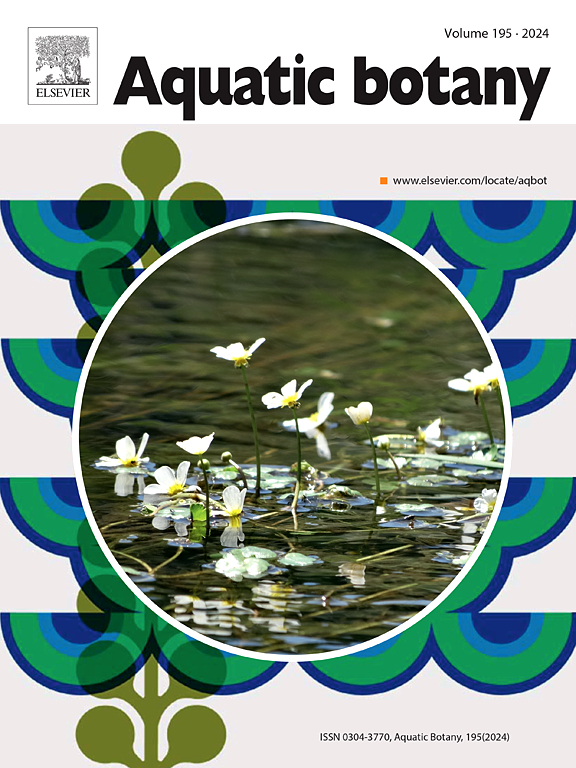Effect of light regime on seedling development of eelgrass (Zostera marina L.)
IF 2.6
4区 生物学
Q2 MARINE & FRESHWATER BIOLOGY
引用次数: 0
Abstract
Light plays a crucial role in plant development and growth. Plants use photoreceptors to perceive light of varying wavelengths and intensities, translating these signals into photoresponses. In the marine environments where seagrasses grow, blue light is predominant due to the absorption of longer wavelengths by water. To elucidate the photoresponses of seagrasses, we analyzed the photoresponses of young seedlings of eelgrass (Zostera marina), whose genome analysis has confirmed the presence of photoreceptors. When cultured under white, blue, green, or red light, the coleoptiles were shorter, and de-etiolated primary leaves were observed. Conversely, under dark conditions, coleoptiles were elongated, and primary leaves did not emerge. These findings indicate that light reduces coleoptile elongation and promotes the emergence and de-etiolation of primary leaves. The reduction in coleoptile elongation was enhanced under intense blue light but diminished under strong red light. Additionally, primary leaf emergence was lowered under high red light conditions. The expression of photoreceptor genes (ZoPHYA, ZoPHYB, and ZoCRY1) was upregulated during seed germination, with ZoPHYA and ZoCRY1 expression being particularly elevated at the coleoptile tips. Our results imply that, in young eelgrass seedlings, red and blue light are perceived at the coleoptile tips, triggering the transition from embryonic to vegetative growth. However, this transition is attenuated by intense red light. This response is likely to be an adaptive mechanism, enabling eelgrass to grow at optimal depths where blue light dominates.
光照条件对大叶藻幼苗发育的影响
光在植物发育和生长中起着至关重要的作用。植物利用光感受器来感知不同波长和强度的光,并将这些信号转化为光响应。在海草生长的海洋环境中,由于水吸收较长的波长,蓝光占主导地位。为了阐明海草的光反应,我们分析了大叶藻幼苗的光反应,其基因组分析证实了光感受器的存在。在白光、蓝光、绿光或红光下培养时,胚芽鞘变短,初生叶去黄化。相反,在黑暗条件下,胚芽被拉长,原叶不出现。这些结果表明,光照减少胚芽鞘伸长,促进初生叶的出芽和去黄化。在强蓝光照射下,胚芽鞘伸长降低幅度增大,而在强红光照射下,胚芽鞘伸长降低幅度减小。此外,在强红光条件下,初生叶出苗率降低。光感受器基因(ZoPHYA、ZoPHYB和ZoCRY1)的表达在种子萌发过程中上调,其中ZoPHYA和ZoCRY1的表达在胚芽鞘尖端特别升高。我们的研究结果表明,在幼嫩的大叶藻幼苗中,红色和蓝色的光在胚芽鞘尖端被感知,触发了从胚胎到营养生长的转变。然而,这种转变被强烈的红光减弱了。这种反应很可能是一种适应机制,使大鳗草能够在蓝光占主导地位的最佳深度生长。
本文章由计算机程序翻译,如有差异,请以英文原文为准。
求助全文
约1分钟内获得全文
求助全文
来源期刊

Aquatic Botany
生物-海洋与淡水生物学
CiteScore
3.80
自引率
5.60%
发文量
70
审稿时长
6 months
期刊介绍:
Aquatic Botany offers a platform for papers relevant to a broad international readership on fundamental and applied aspects of marine and freshwater macroscopic plants in a context of ecology or environmental biology. This includes molecular, biochemical and physiological aspects of macroscopic aquatic plants as well as the classification, structure, function, dynamics and ecological interactions in plant-dominated aquatic communities and ecosystems. It is an outlet for papers dealing with research on the consequences of disturbance and stressors (e.g. environmental fluctuations and climate change, pollution, grazing and pathogens), use and management of aquatic plants (plant production and decomposition, commercial harvest, plant control) and the conservation of aquatic plant communities (breeding, transplantation and restoration). Specialized publications on certain rare taxa or papers on aquatic macroscopic plants from under-represented regions in the world can also find their place, subject to editor evaluation. Studies on fungi or microalgae will remain outside the scope of Aquatic Botany.
 求助内容:
求助内容: 应助结果提醒方式:
应助结果提醒方式:


